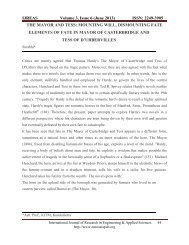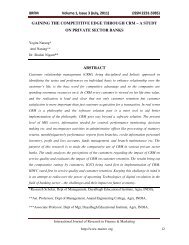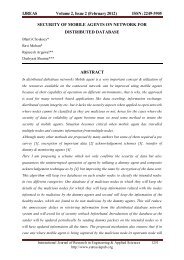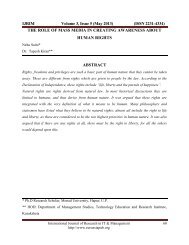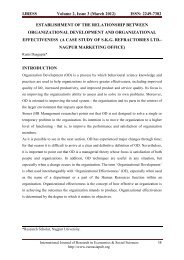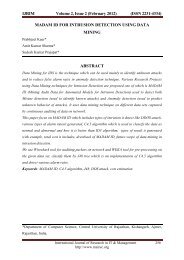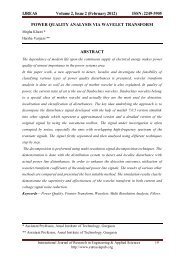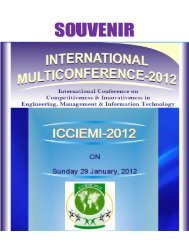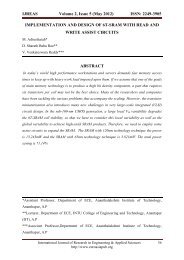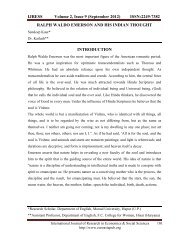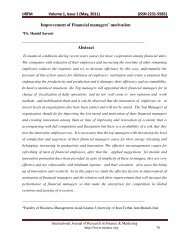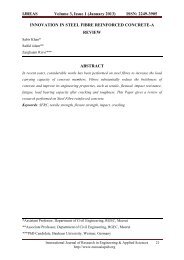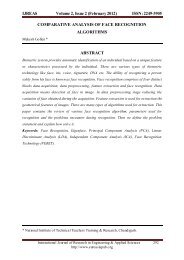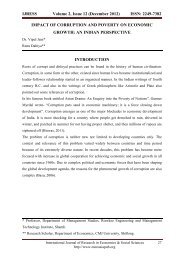to evaluate whether one time investment or ... - Euroasiapub.org
to evaluate whether one time investment or ... - Euroasiapub.org
to evaluate whether one time investment or ... - Euroasiapub.org
Create successful ePaper yourself
Turn your PDF publications into a flip-book with our unique Google optimized e-Paper software.
IJRFM Volume 1, Issue 3 (July, 2011) (ISSN 2231-5985)<br />
TO EVALUATE WHETHER ONE TIME INVESTMENT OR<br />
SYSTEMATIC INVESTMENT PLAN (SIP) WOULD GIVE HIGHER<br />
RETURNS AND TO FIND OUT THE TOP FIVE SCHEMES ON THE<br />
BASIS OF RETURN IN THE SAME – A CASE STUDY OF HDFC BANK<br />
Shelly Singhal*<br />
Manisha Goel**<br />
ABSTRACT<br />
Indian Mutual fund industry has witnessed a structural transf<strong>or</strong>mation during the past many<br />
years. Systematic Investment Plans (SIP) is among the most successful financial innovations<br />
grown at a fairly rapid pace in emerging markets and India is no exception <strong>to</strong> it. This paper<br />
aims at evaluating the perf<strong>or</strong>mance of SIP plans against <strong>one</strong> <strong>time</strong> <strong>investment</strong>. HDFC mutual<br />
funds return has been compared with the HDFC SIP return f<strong>or</strong> the past 10 year period from<br />
April1, 2001 <strong>to</strong> Feb, 28,2011.F<strong>or</strong> this purpose we have used annual returns based on<br />
NAV(Net Asset Value).CRISIL has been used as a proxy f<strong>or</strong> benchmark return, while annual<br />
yields on 364-day Treasury bill as a surrogate f<strong>or</strong> the Risk free rate of Return.The <strong>investment</strong><br />
perf<strong>or</strong>mance has been measured in terms of Sharpe’s Ratio, Treyn<strong>or</strong>’s Ratio and Jensen<br />
Ratio. The Empirical result rep<strong>or</strong>ted that SIP Plans has perf<strong>or</strong>med better than the <strong>one</strong> <strong>time</strong><br />
<strong>investment</strong>. After that, from the various SIP Plans available <strong>to</strong>p five plans have been found<br />
out by doing ranking of the Returns from the various kinds of SIP Plans.<br />
Keyw<strong>or</strong>ds: Mutual funds, SIP (Systematic Investment Plan), Net Asset Value<br />
*Lecturer,Maharaja Agrasen Institute of Management and Technology, Jagadhri, Haryana,<br />
India<br />
**Maharaja Agrasen Institute of Management and Technology, Jagadhri, Haryana, India<br />
International Journal of Research in Finance & Marketing<br />
http://www.mairec <strong>or</strong>g 90
IJRFM Volume 1, Issue 3 (July, 2011) (ISSN 2231-5985)<br />
INTRODUCTION<br />
S<strong>to</strong>ck selection is the nucleus of <strong>investment</strong> decision making as it determines the con<strong>to</strong>ur of risk<br />
bearing & diversification. Generally, the inves<strong>to</strong>rs get confused regarding the <strong>investment</strong> option<br />
<strong>whether</strong> <strong>to</strong> go f<strong>or</strong> <strong>one</strong> <strong>time</strong> <strong>or</strong> systematic mode of investing and they generally remain in a<br />
dilemma of in which plan <strong>to</strong> invest in <strong>to</strong> get maximum returns. Hence the decision is <strong>to</strong> be taken<br />
regarding which mode of <strong>investment</strong> should be adopted. This decision can be taken by<br />
comparing the risk & return from each mode of <strong>investment</strong>. not only this, even when a particular<br />
mode of <strong>investment</strong> is selected there still remains a confusion regarding in which plan the m<strong>one</strong>y<br />
should be invested as there are a number of plans available with a mode of <strong>investment</strong>. So in this<br />
study the researcher has tried <strong>to</strong> reveal ,out of SIP & One –Time Investment which option is<br />
better taking the case of HDFC Bank.<br />
The Systematic Investment Plan (SIP) is a simple and <strong>time</strong> hon<strong>or</strong>ed <strong>investment</strong> strategy f<strong>or</strong><br />
accumulation of wealth in a disciplined manner over long term period .In case of systematic<br />
<strong>investment</strong> plan; a specific amount is invested at specific period of <strong>time</strong> so the average cost of<br />
<strong>investment</strong> is reduced as the amount is invested. It can also be called as a Rupee cost averaging<br />
f<strong>or</strong>mula Plan which is a passive P<strong>or</strong>tfolio Revision Strategy.<br />
Let us assume that an inves<strong>to</strong>r decides <strong>to</strong> buy approx Rs 1000 w<strong>or</strong>th shares f<strong>or</strong> four Quarters in<br />
<strong>one</strong> Particular Year, ign<strong>or</strong>ing the transaction costs and share price movements, the details are<br />
given as under:-<br />
Quarter Market<br />
Price<br />
Shares<br />
Purchased<br />
Rupee cost averaging<br />
Cumulative<br />
Investment<br />
Market<br />
Value<br />
Rs.)<br />
(in<br />
Profit/loss<br />
Average<br />
cost<br />
share<br />
1 100 10 1000 1000 0 100 100<br />
2 90 11 1990 1890 (100) 94.76 95<br />
International Journal of Research in Finance & Marketing<br />
http://www.mairec <strong>or</strong>g 91<br />
per<br />
Average<br />
Market<br />
price<br />
per<br />
share<br />
3 100 10 2990 3100 110 96.45 96.67
IJRFM Volume 1, Issue 3 (July, 2011) (ISSN 2231-5985)<br />
4 110 9 3980 4400 420 99.50 100<br />
Source –Punitavathy & Pandian(SAPM)<br />
In the above example, the s<strong>to</strong>ck price fell in the second quarter but recovered in the third quarter.<br />
So the no. of shares purchased varies in each quarter.The inves<strong>to</strong>r was able <strong>to</strong> buy m<strong>or</strong>e s<strong>to</strong>ck in<br />
second quarter instead of first quarter. In the second quarter, the average cost per share is lower<br />
than the average market price per share. This is the benefit derived from SIP.<br />
SELECTIVE REVIEW OF LITERATURE<br />
Sen(2009) concluded that the average perf<strong>or</strong>mance of sample mutual funds lagged behind the<br />
average returns of the market proxy. The researcher found that the perf<strong>or</strong>mance of mutual funds<br />
in India supp<strong>or</strong>t the Efficient Market Hypothesis and the fund managers do not make use of any<br />
superi<strong>or</strong> inf<strong>or</strong>mation f<strong>or</strong> fund selection. Singh (2003) calculated that the salaried class people &<br />
retired people give maximum weight <strong>to</strong> past rec<strong>or</strong>d of the <strong>or</strong>ganization while business class<br />
people give preference <strong>to</strong> liquidity position. As per scheme wise breakup, out of the <strong>to</strong>tal<br />
schemes currently operative, income/debt schemes outnumbered the growth and balanced<br />
schemes. Chander (2005) studied that Investment perf<strong>or</strong>mance on the s<strong>to</strong>ck selection refers <strong>to</strong><br />
the managers’ ability <strong>to</strong> identify under <strong>or</strong> overvalued securities. The auth<strong>or</strong> examined the s<strong>to</strong>ck<br />
selection abilities of <strong>investment</strong> managers’ in India across the fund features as well as the<br />
persistence of such perf<strong>or</strong>mance. Guha Deb (2008) find that Investment style of a fund refers <strong>to</strong><br />
the combination of long positions in passive indexes, which would have most closely replicated<br />
the actual perf<strong>or</strong>mance of a fund over a specified <strong>time</strong> period. The auth<strong>or</strong> finds that all domestic<br />
asset classes have generated positive mean monthly returns with return and volatility increasing<br />
commensurately. Sethu & Baid (2003) they concluded that the valuation of the netw<strong>or</strong>th of the<br />
AMCs is influenced by the nature of the scheme and the growth rate in AUM envisaged. They<br />
also find that the AMCs are not listed. Ansari (2007) concluded that the relation between the<br />
fund size and the mutual fund perf<strong>or</strong>mance has been an unsettled issue as the empirical studies<br />
have rep<strong>or</strong>ted mixed results. The study reveals a quadratic relationship between the size and<br />
perf<strong>or</strong>mance of mutual funds. Gupta (2004) found that sample funds are not adequately<br />
diversified. . The auth<strong>or</strong> suggested that there is no conclusive evidence, which suggests that the<br />
perf<strong>or</strong>mance of mutual funds is superi<strong>or</strong> <strong>to</strong> the market during the study period.<br />
International Journal of Research in Finance & Marketing<br />
http://www.mairec <strong>or</strong>g 92
IJRFM Volume 1, Issue 3 (July, 2011) (ISSN 2231-5985)<br />
OBJECTIVES<br />
The objectives of the study are:<br />
To have a comparative analysis of return while investing in mutual funds via <strong>one</strong> <strong>time</strong><br />
<strong>investment</strong> and SIP as per Sharpe, Treyn<strong>or</strong> & Jensen ratio<br />
To find the <strong>to</strong>p 5 schemes (SIP) as per Sharpe, Treyn<strong>or</strong> & Jensen among all the options<br />
available with special reference <strong>to</strong> HDFC Mutual Fund<br />
The<strong>or</strong>etical Framew<strong>or</strong>k<br />
Construct: “To study which <strong>investment</strong> option <strong>whether</strong> SIP <strong>or</strong> One Time Investment, is a better<br />
option<br />
Variables: There are basically two types of Variables, as follows:<br />
• Independent Variable<br />
• Dependent Variable<br />
The following are the variables of the study:<br />
Independent Variable:<br />
<br />
Market Rate of Return<br />
<br />
Risk free Rate of Return<br />
<br />
Benchmark i.e. CRISIL return<br />
Dependent variable:<br />
NAV of SIP Plan<br />
NAV of On <strong>time</strong> Investment<br />
Standard Deviation of SIP plan<br />
Standard Deviation of One Time Investment<br />
Moderating variable:<br />
International Journal of Research in Finance & Marketing<br />
http://www.mairec <strong>or</strong>g 93
IJRFM Volume 1, Issue 3 (July, 2011) (ISSN 2231-5985)<br />
<br />
HDFC Mutual Funds<br />
Research Design:<br />
The purpose of this study is descriptive. A descriptive study is undertaken in <strong>or</strong>der <strong>to</strong> be able <strong>to</strong><br />
describe the characteristics of variables of interest in a situation. In this type of research the<br />
researcher has no control over the variables; he can only rep<strong>or</strong>t what has happened <strong>or</strong> what is<br />
happening.<br />
Data & other sources<br />
i) The sample<br />
The researcher has used a sample of 24 funds of HDFC including SIP & One Time Investment<br />
<strong>to</strong> study their perf<strong>or</strong>mance. The choice of the sample is largely based on the availability of<br />
necessary data. Annual return based on NAV ( Net Asset Value) have been used f<strong>or</strong><br />
perf<strong>or</strong>mance evaluation. The data regarding the sample funds used in the study has been taken<br />
from the Monthly Factsheet available on the company website (www.hdfcbank.com)<br />
ii) Period of study<br />
The study period is the ten years period from April 1, 2001 <strong>to</strong> 28 feb, 2011. It is during this<br />
period that a maj<strong>or</strong> structural change has taken place in the Indian Mutual Fund Industry. The<br />
period is long enough <strong>to</strong> draw meaningful inferences.<br />
iii) The Market Proxy<br />
F<strong>or</strong> evaluating the <strong>investment</strong> perf<strong>or</strong>mance, it is necessary <strong>to</strong> choose a benchmark against<br />
which the perf<strong>or</strong>mance of sample fund is compared .The researcher has used CRISIL as a<br />
benchmark as it is widely use index use by both practiti<strong>one</strong>rs and researchers.<br />
iv) The Risk Free Proxy<br />
The study has used the annual yields on 364-day Treasury bill as a surrogate f<strong>or</strong> the Risk<br />
free rate of Return.<br />
International Journal of Research in Finance & Marketing<br />
http://www.mairec <strong>or</strong>g 94
IJRFM Volume 1, Issue 3 (July, 2011) (ISSN 2231-5985)<br />
v) Beta of the fund<br />
The data regarding the Beta of the fund is taken from the Monthly Factsheet of the company.<br />
Methodology<br />
Perf<strong>or</strong>mance Evaluation Measures<br />
The researcher have utilized following measures <strong>to</strong> <strong>evaluate</strong> perf<strong>or</strong>mance:-<br />
a) Sharpe ratio<br />
Sharpe (1966) devised an index of p<strong>or</strong>tfolio perf<strong>or</strong>mance measure, referred <strong>to</strong> as reward <strong>to</strong><br />
variability ratio denoted by Sp. It measures the excess return per unit of <strong>to</strong>tal risk as measured by<br />
standard deviation. The Sharpe ratio f<strong>or</strong> different mutual funds, as well as benchmark p<strong>or</strong>tfolios,<br />
has been computed by using the following equation:<br />
Sp= Risk premium/Total Risk<br />
= Rp-Rf<br />
S.D. p<br />
Where,<br />
Sp=<br />
Rp=<br />
Rf=<br />
Sharpe ratio<br />
p<strong>or</strong>tfolio return<br />
risk-free return<br />
S.D.p= standard deviation of p<strong>or</strong>tfolio<br />
The Sp f<strong>or</strong> benchmark p<strong>or</strong>tfolio is Rm-Rf/S.D.m, where S.D. is the standard deviation of market<br />
returns.<br />
If Sp of the mutual fund scheme is greater than that of the market p<strong>or</strong>tfolio, the fund has<br />
outperf<strong>or</strong>med the market. Sharpe ratio is considered better as it considers the <strong>to</strong>tal risk.<br />
International Journal of Research in Finance & Marketing<br />
http://www.mairec <strong>or</strong>g 95
IJRFM Volume 1, Issue 3 (July, 2011) (ISSN 2231-5985)<br />
b) Treyn<strong>or</strong> Ratio<br />
The Treyn<strong>or</strong> reward <strong>to</strong> volatility ratio measures the excess return per unit of market<br />
(systematic) risk. The Treyn<strong>or</strong> ratio f<strong>or</strong> the sample funds has been calculated as follow:-<br />
Tp= risk premium<br />
Systematic risk<br />
= Rp-Rf/βp<br />
Where,<br />
Tp=Treyn<strong>or</strong> ratio<br />
Rp= return from p<strong>or</strong>tfolio<br />
Rf= risk-free return<br />
βp= Bata coefficient f<strong>or</strong> p<strong>or</strong>tfolio<br />
As the market Beta is 1, Treyn<strong>or</strong> index Tp f<strong>or</strong> market p<strong>or</strong>tfolio is (Rm-Rf) where Rm is the<br />
market return.<br />
If Tp of the mutual fund scheme is greater than (Rm-Rf), then the fund has outperf<strong>or</strong>med the<br />
market. The maj<strong>or</strong> limitation of the Treyn<strong>or</strong> ratio is that it ign<strong>or</strong>es the reward f<strong>or</strong><br />
unsystematic risk.<br />
c) Jensen ratio<br />
This ratio attempts <strong>to</strong> measure the differential between the actual return earned on a p<strong>or</strong>tfolio<br />
and the return expected from the p<strong>or</strong>tfolio given its level of risk.<br />
The expected return of the p<strong>or</strong>tfolio is calculated as under:-<br />
E (Rp) =Rf+βp (Rm-Rf)<br />
Where,<br />
International Journal of Research in Finance & Marketing<br />
http://www.mairec <strong>or</strong>g 96
IJRFM Volume 1, Issue 3 (July, 2011) (ISSN 2231-5985)<br />
E (Rp) = expected p<strong>or</strong>tfolio return<br />
Rf= risk-free rate<br />
Rm= return on market index<br />
βp= systematic risk of the p<strong>or</strong>tfolio<br />
the differential return is calculated as follow:<br />
αp =Rp-E(Rp)<br />
Where,<br />
αp =Differential return earned<br />
Rp= Actual return earned on the p<strong>or</strong>tfolio<br />
E (Rp) = Expected return<br />
If αp has a positive value, it indicates that the superi<strong>or</strong> return has been earned due <strong>to</strong> superi<strong>or</strong><br />
management skills.<br />
When αp =0, it indicates neutral perf<strong>or</strong>mance. It means that the p<strong>or</strong>tfolio manager has d<strong>one</strong><br />
just as well as an unmanaged randomly selected p<strong>or</strong>tfolio with a buy and hold strategy.<br />
RESULTS &DISCUSSION<br />
Objective 1: To have a comparative analysis of return while investing in mutual funds via<br />
<strong>one</strong> <strong>time</strong> <strong>investment</strong> and SIP as per Sharpe, Treyn<strong>or</strong> & Jensen measure.<br />
Comparison of return of schemes from SIP & <strong>one</strong>-Time <strong>investment</strong> as per Sharpe<br />
Measure<br />
Comparison of returns as per Sharpe measure<br />
Scheme<br />
R p (<strong>one</strong><br />
R p (SIP)<br />
SD (<strong>one</strong><br />
SD (SIP)<br />
One <strong>time</strong><br />
SIP<br />
<strong>time</strong>)<br />
<strong>time</strong>)<br />
<strong>investment</strong><br />
Return(as<br />
return(as<br />
per<br />
International Journal of Research in Finance & Marketing<br />
http://www.mairec <strong>or</strong>g 97
IJRFM Volume 1, Issue 3 (July, 2011) (ISSN 2231-5985)<br />
per sharpe) sharpe)<br />
Tax Saver Fund 22.36 31.99 12.23 15.92 30.32 31.62<br />
Equity Fund 22.17 28.64 11.73 15.49 21.88 28.26<br />
Capital builder 14.66 20.36 10.14 14.49 14.08 19.95<br />
fund<br />
Growth Fund 24.74 26.57 11.85 13.59 21.67 26.14<br />
Top 200 Fund 30.81 26.5 12.05 15.01 24.24 26.11<br />
Risk- free return=5.82 (364 days t-bills yield 0n 28-02-11<br />
(source:hdfcbank.com/monthlysheet)<br />
35<br />
30<br />
25<br />
20<br />
15<br />
10<br />
5<br />
SIP return<br />
<strong>one</strong> <strong>time</strong> <strong>investment</strong><br />
return<br />
0<br />
tax saver<br />
fund<br />
equity<br />
fund<br />
capital<br />
builder<br />
fund<br />
growth<br />
fund<br />
<strong>to</strong>p 200<br />
fund<br />
Comparison of returns as per Sharpe measure<br />
Interpretation<br />
The result of graph shows that the return from the SIP is much higher than the return from <strong>one</strong><br />
<strong>time</strong> <strong>investment</strong>. So it is m<strong>or</strong>e beneficial <strong>to</strong> invest in SIP plans instead of <strong>one</strong> <strong>time</strong> <strong>investment</strong>.<br />
Also there is no need <strong>to</strong> invest all the m<strong>one</strong>y in lump sum.<br />
Comparison of return of schemes from SIP & <strong>one</strong> <strong>time</strong> <strong>investment</strong> as per Treyn<strong>or</strong> Measure<br />
Comparison of returns as per Treyn<strong>or</strong> measure<br />
International Journal of Research in Finance & Marketing<br />
http://www.mairec <strong>or</strong>g 98
IJRFM Volume 1, Issue 3 (July, 2011) (ISSN 2231-5985)<br />
Scheme Beta R p (<strong>one</strong> R p (SIP) One <strong>time</strong> SIP Return<br />
<strong>time</strong>)<br />
<strong>investment</strong><br />
return<br />
Tax Saver Fund 2.69 22.36 31.99 28.64 29.82<br />
Equity Fund 2.69 22.17 28.64 20.19 26.47<br />
Capital builder 2.69 14.66 20.36 12.49 18.19<br />
fund<br />
Growth Fund 2.69 24.74 26.57 20 24.40<br />
Top 200 Fund 2.69 30.81 26.5 22.57 24.33<br />
Risk- free return=5.82 (364 days t-bills yield 0n 28-02-11)<br />
(source:hdfcbank.com/monthlysheet)<br />
35<br />
30<br />
25<br />
20<br />
15<br />
10<br />
5<br />
One <strong>time</strong> <strong>investment</strong><br />
SIP Return<br />
0<br />
Tax<br />
Saver<br />
Fund<br />
Equity<br />
Fund<br />
Capital<br />
builder<br />
fund<br />
Growth<br />
Fund<br />
Top 200<br />
Fund<br />
Comparison of returns as per Treyn<strong>or</strong> measure<br />
Interpretation<br />
The result as per Treyn<strong>or</strong> measure also shows that the return from SIP is much higher in<br />
comparison <strong>to</strong> return from <strong>one</strong> <strong>time</strong> <strong>investment</strong>. It shows that SIP plans are m<strong>or</strong>e schemes<br />
profitable in comparison <strong>to</strong> <strong>one</strong> <strong>time</strong> <strong>investment</strong>.<br />
International Journal of Research in Finance & Marketing<br />
http://www.mairec <strong>or</strong>g 99
IJRFM Volume 1, Issue 3 (July, 2011) (ISSN 2231-5985)<br />
Comparison of return of schemes from SIP & <strong>one</strong> <strong>time</strong> <strong>investment</strong> as per Jensen Measure<br />
Comparison of returns as per Jensen measure<br />
Scheme Beta R m (One<br />
R m (SIP)<br />
One <strong>time</strong><br />
SIP Return<br />
<strong>time</strong> )<br />
<strong>investment</strong><br />
Return<br />
Tax Saver Fund 2.69 22.36 31.99 73.04 76.21<br />
Equity Fund 2.69 22.17 28.64 50.31 67.20<br />
Growth Fund 2.69 14.66 20.36 49.80 61.63<br />
Top 200 Fund 2.69 24.74 26.57 56.71 61.44<br />
Capital builder Fund 2.69 30.81 26.5 29.59 44.93<br />
Risk- free return=5.82 (364 days t-bills yield 0n 28-02-11)<br />
(source:hdfcbank.com/monthlysheet)<br />
90<br />
80<br />
70<br />
60<br />
50<br />
40<br />
30<br />
20<br />
<strong>one</strong> <strong>time</strong> <strong>investment</strong><br />
return<br />
SIP Return<br />
10<br />
0<br />
Tax<br />
Saver<br />
Fund<br />
Equity<br />
Fund<br />
Growth<br />
Fund<br />
Top 200<br />
Fund<br />
Capital<br />
builder<br />
Fund<br />
Comparison of returns as per Jensen measure<br />
Interpretation : As per Jensen ratio also return from SIP plans is m<strong>or</strong>e than return from <strong>one</strong><br />
<strong>time</strong> <strong>investment</strong>. The result from all these shows that SIP plans are better than <strong>one</strong> <strong>time</strong><br />
<strong>investment</strong> schemes. SIP plans are beneficial over a long period of <strong>time</strong>.<br />
International Journal of Research in Finance & Marketing<br />
http://www.mairec <strong>or</strong>g 100
IJRFM Volume 1, Issue 3 (July, 2011) (ISSN 2231-5985)<br />
Objective 2 To find the <strong>to</strong>p 5 schemes (SIP) as per Sharpe, Treyn<strong>or</strong> & Jensen among all the<br />
options available with special reference <strong>to</strong> HDFC Mutual Fund<br />
Table-32, Ranking of SIP schemes on the basis of Sharpe’s index<br />
Scheme<br />
Sharpe ratio<br />
= Rp-Rf<br />
S.D. p<br />
Rank<br />
Growth Fund 26.14 4<br />
Equity Fund 28.26 2<br />
Top 200 Fund 26.11 5<br />
Capital Builder Fund 19.95 7<br />
Multi Cap Fund 13.90 11<br />
C<strong>or</strong>e & Satellite Fund 16.89 9<br />
Balance Fund 18.39 8<br />
Prudence Fund 23.57 6<br />
Children Gift Fund 16.88 10<br />
Children Saving Plan 8.67 13<br />
Long term Advantage Fund 27.17 3<br />
Tax Saver Fund 31.62 1<br />
MF MIP-Sh<strong>or</strong>t Term 5.75 14<br />
MF MIP- Long Term 10.80 12<br />
Returns from <strong>to</strong>p 5 SIP plans as per Sharpe measure<br />
SIP Scheme<br />
SIP Return<br />
Tax Saver Fund 31.62<br />
Equity Fund 28.26<br />
Long term advantage fund 27.17<br />
Growth Fund 26.14<br />
Top 200 Fund 26.11<br />
International Journal of Research in Finance & Marketing<br />
http://www.mairec <strong>or</strong>g 101
IJRFM Volume 1, Issue 3 (July, 2011) (ISSN 2231-5985)<br />
SIP Return<br />
35<br />
30<br />
25<br />
20<br />
15<br />
10<br />
SIP Return<br />
5<br />
0<br />
Tax Saver<br />
Fund<br />
Equity Fund Long term<br />
advantage<br />
fund<br />
Growth<br />
Fund<br />
Top 200<br />
Fund<br />
Figure-Top 5 SIP plans as per Sharpe measure<br />
Interpretation<br />
As per Sharpe Ratio among SIP Plans Tax Saver Fund has shown the best result over <strong>time</strong>.<br />
Perf<strong>or</strong>mance of Equity Fund is also good.<br />
Ranking of SIP schemes on the basis of Treyn<strong>or</strong>’s index<br />
Scheme Treyn<strong>or</strong> Ratio = Rp-Rf/βp Rank<br />
Growth Fund 24.40 4<br />
Equity Fund 26.47 2<br />
Top 200 Fund 24.33 5<br />
Capital Builder Fund 18.19 7<br />
Multi Cap Fund 12.09 11<br />
C<strong>or</strong>e & Satellite Fund 15.07 10<br />
Balance Fund 16.80 8<br />
Prudence Fund 21.85 6<br />
Children Gift Fund 15.40 9<br />
Children Saving Plan 8.10 13<br />
Long term Advantage Fund 25.43 3<br />
International Journal of Research in Finance & Marketing<br />
http://www.mairec <strong>or</strong>g 102
IJRFM Volume 1, Issue 3 (July, 2011) (ISSN 2231-5985)<br />
Tax Saver Fund 29.82 1<br />
MF MIP-Sh<strong>or</strong>t Term 4.86 14<br />
MF MIP- Long Term 9.59 12<br />
Return from Top 5 SIP plans as per Treyn<strong>or</strong> measure<br />
Scheme<br />
SIP Return<br />
Tax Saver Fund 29.82<br />
Equity Fund 26.47<br />
Long term advantage fund 25.43<br />
Growth Fund 24.40<br />
Top 200 Fund 24.33<br />
SIP Return<br />
35<br />
30<br />
25<br />
20<br />
15<br />
10<br />
SIP Return<br />
5<br />
0<br />
Tax Saver<br />
Fund<br />
Equity Fund Long term<br />
advantage<br />
fund<br />
Growth<br />
Fund<br />
Top 200<br />
Fund<br />
Interpretation<br />
Figure- Return from Top 5 SIP plans as per Treyn<strong>or</strong> measure<br />
As per Treyn<strong>or</strong> ratio Tax Saver Fund has shown the best perf<strong>or</strong>mance. It is 29.82%.<br />
International Journal of Research in Finance & Marketing<br />
http://www.mairec <strong>or</strong>g 103
IJRFM Volume 1, Issue 3 (July, 2011) (ISSN 2231-5985)<br />
Table-36 Ranking of SIP schemes on the basis of Jensen’s index<br />
Scheme Jensen Ratio Rank<br />
Growth Fund 61.63 4<br />
Equity Fund 67.20 2<br />
Top 200 Fund 61.44 5<br />
Capital Builder Fund 44.93 7<br />
Multi Cap Fund 28.52 11<br />
C<strong>or</strong>e & Satellite Fund 36.53 10<br />
Balance Fund 41.19 8<br />
Prudence Fund 54.77 6<br />
Children Gift Fund 37.42 9<br />
Children Saving Plan 17.79 13<br />
Long term Advantage Fund 64.40 3<br />
Tax Saver Fund 76.21 1<br />
MF MIP-Sh<strong>or</strong>t Term 9.07 14<br />
MF MIP- Long Term 21.79 12<br />
Return from Top 5 SIP plans as per Jensen measure<br />
Scheme<br />
SIP return<br />
Tax Saver Fund 76.21<br />
Equity Fund 67.20<br />
Long term advantage fund 64.40<br />
Growth Fund 61.63<br />
Top 200 Fund 61.44<br />
International Journal of Research in Finance & Marketing<br />
http://www.mairec <strong>or</strong>g 104
IJRFM Volume 1, Issue 3 (July, 2011) (ISSN 2231-5985)<br />
SIP return<br />
90<br />
80<br />
70<br />
60<br />
50<br />
40<br />
30<br />
20<br />
10<br />
0<br />
SIP return<br />
Tax Saver<br />
Fund<br />
Equity Fund Long term<br />
advantage<br />
fund<br />
Growth<br />
Fund<br />
Top 200<br />
Fund<br />
Return from Top 5 SIP plans as per Jensen measure<br />
Interpretation<br />
As per Jensen ratio also Tax Saver Fund has shown the best perf<strong>or</strong>mance. It is 76.21%.<br />
The maj<strong>or</strong> findings of the study are as under:<br />
Objective 1: To have a comparative analysis of return while investing in mutual funds via<br />
<strong>one</strong> <strong>time</strong> <strong>investment</strong> and SIP as per Sharpe, Treyn<strong>or</strong> & Jensen measure.<br />
Findings<br />
The comparative analysis of return as per Sharpe, Treyn<strong>or</strong> & Jensen measure shows that<br />
the return from the SIP is much better than the return from <strong>one</strong> <strong>time</strong> mode of <strong>investment</strong>.<br />
under Taxsaver fund the return from SIP is 31.62% while under <strong>one</strong> <strong>time</strong> mode of<br />
<strong>investment</strong> it is 30.32%.<br />
Instead of return the amount needed <strong>to</strong> invest in SIP is also less, so it is profitable <strong>to</strong><br />
invest in SYSTEMATIC INVESTMENT PLANS.<br />
International Journal of Research in Finance & Marketing<br />
http://www.mairec <strong>or</strong>g 105
IJRFM Volume 1, Issue 3 (July, 2011) (ISSN 2231-5985)<br />
Objective 2: To find the Top 5 schemes (SIP) as per Sharpe, Treyn<strong>or</strong> & Jensen measure<br />
among all the options available with special reference <strong>to</strong> HDFC Mutual Fund.<br />
Findings<br />
As per all the measures Tax saver fund has perf<strong>or</strong>med best among all the SIP plans.<br />
Equity fund has been ranked as 2 while long term advantage fund, Growth fund & Top<br />
200 fund has been ranked as 3, 4&5.<br />
It shows that the results of all the schemes as per Sharpe, Treyn<strong>or</strong> &Jensen measure are<br />
same.<br />
CONCLUSION<br />
This paper has aimed at testing the perf<strong>or</strong>mance of SIP Plans against <strong>one</strong> <strong>time</strong> <strong>investment</strong>. Using<br />
HDFC bank SIP plans and <strong>one</strong> <strong>time</strong> <strong>investment</strong> plan as the sample and annual returns based on<br />
NAV, the results indicated that the return from the SIP is much better than the return from <strong>one</strong><br />
<strong>time</strong> <strong>investment</strong> mode. In <strong>or</strong>der <strong>to</strong> get better results from SIP these plans should be held f<strong>or</strong> a<br />
long period of <strong>time</strong> and the revision of plans <strong>to</strong> be included in p<strong>or</strong>tfolio is necessary so that the<br />
results are better. In <strong>or</strong>der <strong>to</strong> know about the profitability of various plans their comparative<br />
study & c<strong>or</strong>pus of fund should be studied as per various analytical measures. By studying the<br />
c<strong>or</strong>pus of a fund inf<strong>or</strong>mation regarding allocation of funds is known and acc<strong>or</strong>dingly the decision<br />
<strong>to</strong> invest in a particular scheme can be taken. Overall, the results rep<strong>or</strong>ted here are in consensus<br />
with the <strong>one</strong>s rep<strong>or</strong>ted earlier from the f<strong>or</strong>eign markets.<br />
REFERENCES<br />
Sethu(2003), Valuation of Asset Management Companies-AFree Cash Flow Approach, The<br />
ICFAI Journal of Applied Finance, vol.9, 5-20<br />
Ansari (2007), Influence of Fund size on the perf<strong>or</strong>mance of a Mutual Fund, NICE Journal of<br />
Business, vol.2, no.2, 81-86<br />
International Journal of Research in Finance & Marketing<br />
http://www.mairec <strong>or</strong>g 106
IJRFM Volume 1, Issue 3 (July, 2011) (ISSN 2231-5985)<br />
Gupta (2004), Perf<strong>or</strong>mance Evaluation of Selected Indian Mutual Fund Schemes, The ICFAI<br />
Journal of Applied Finance, vol.1, 81-97<br />
Tripathy (2004), An Empirical Analysis on Perf<strong>or</strong>mance Evaluation of Mutual Funds in India,<br />
The ICFAI Journal of Applied Finance, vol.4, 38-55<br />
Sen (2009), Understanding the Perf<strong>or</strong>mance of Mutual Funds in India, Bhavishya Journal of<br />
Future Business School, vol.3, No.1,13-26<br />
Sahoo (2007), Prediction of Mutual Funds: Use of Neural Netw<strong>or</strong>k Technique, The ICFAI<br />
Journal of Applied Finance, vol. 13, No. 11, 5-14<br />
Slaheddine (2003), The Implication of Arbitrage Strategies on Perf<strong>or</strong>mance Persistence:<br />
Evidence on Tunisian Mutual Funds, Finance India, vol. XVII, No. 3, 931-937.<br />
Grinblatt (1984), The Persistence of Perf<strong>or</strong>mance of Mutual Fund, Journal of Finance, vol.47,<br />
1979-1983<br />
Catrinu(2007), A Risk Based Approach <strong>to</strong> Distribution System Asset Management and a<br />
Survey of Perceived Risk Exposure among Distribution Companies, 19th International<br />
Conference on Electricity Distribution,1-4<br />
Chevalier (1997), Risk Taking by Mutual Funds as a response <strong>to</strong> Incentives, The Journal of<br />
Political Economy, vol.105, No.6, 1167-1200<br />
Edelen (1999), Inves<strong>to</strong>r flows and the assessed perf<strong>or</strong>mance of open-end mutual funds, Journal<br />
of Financial Economics 53, 439-466<br />
Titman(1993), Perf<strong>or</strong>mance measurement without benchmarks: an examination of mutual fund<br />
returns, Journal of Business , vol.23, 66-68.<br />
Grinblatt(1994), A study of mutual fund returns and perf<strong>or</strong>mance evaluation techniques, Journal<br />
of Financial and Quantitative Analysis vol.29, 419-444.<br />
International Journal of Research in Finance & Marketing<br />
http://www.mairec <strong>or</strong>g 107
IJRFM Volume 1, Issue 3 (July, 2011) (ISSN 2231-5985)<br />
Henriksson(1984), Market timing and mutual fund perf<strong>or</strong>mance: an empirical investigation.,<br />
Journal of Business , vol.57, 73-96.<br />
Jensen(1968), The perf<strong>or</strong>mance of mutual funds in the period 1945-1964, Journal of Finance,<br />
vol. 23, 389-416.<br />
Gruber(1996), Another puzzle: the growth of actively managed mutual funds, Journal of<br />
Finance, vol. 51, 783-810.<br />
Ingves(2004), Issues in the Establishment of Asset Management Companies, IMF Policy<br />
Discussion Paper,1-28<br />
Daniela(2000), The Use of Asset Management Companies in the Resolution of Banking Crises:<br />
Cross-Country Experience, W<strong>or</strong>ld Bank Policy Research Paper No.<br />
2284.<br />
Guifen Pei(2004), The Main Problems of China’s financial Industry and Asset Management<br />
Companies, Habei University and Keio University,1-16<br />
International Journal of Research in Finance & Marketing<br />
http://www.mairec <strong>or</strong>g 108



